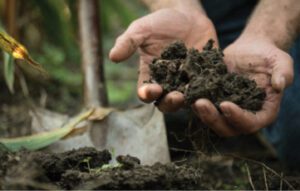
Regenerative Agriculture is a term that is being widely used by everyone from farmers to consumers to politicians, but what does it mean? A study published in Frontiers in Sustainable Food Systems in 2020 looked at how the term “regenerative agriculture” was used in 229 scholarly articles and found that while there was not a consistent definition across the board. However, there were five main regenerative principles that were widely agreed upon:
- Improving soil health
- Increasing biodiversity
- Increasing carbon cycling and sequestration
- Integrating properly managed livestock
- Improving the overall larger ecosystem as a whole.
In its simplest terms, it is a system of farming that applies the principles of soil health (see pages 4-10) to the practice of farming and ranching. Gabe Brown puts it well when he says: ”Regenerative Agriculture is an understanding that one must work with nature instead of against her.” (Green Cover Soil Health Resource Guide version 6)
We also like what our friends at the Noble Research Institute have to say about the topic: To us, regenerative agriculture is the process of restoring degraded soils using practices based on ecological principles. Regenerative agriculture is a journey, not a destination. It begins with an understanding that the soil,
plants, animals and humans are all connected, meaning every decision must work with this natural system and not in spite of it.” (Green Cover Soil Health Resource Guide version 7)
Wikipedia actually explains it pretty well also: Regenerative agriculture is a conservation and rehabilitation approach to food and farming systems. It focuses on topsoil regeneration, increasing biodiversity, improving the water cycle, enhancing ecosystem services, supporting bio-sequestration, increasing resilience to climate change, and strengthening the health and vitality of farm soil. Regenerative agriculture is not a specific practice itself. Rather, proponents of regenerative agriculture utilize a variety of other sustainable agriculture techniques in combination. Practices include recycling as much farm waste as possible and adding composted material from sources outside the farm. Regenerative agriculture on small farms and gardens is often based on philosophies like permaculture, agroecology, agroforestry, restoration ecology, keyline design, and holistic management. Large farms tend to be less philosophy driven and often use “no-till” and/or “reduced till” practices. As soil health improves, input requirements may decrease, and crop yields may increase as soils are more resilient against extreme weather and harbor fewer pests and pathogens.
Regenerative Agriculture is neither a new term nor a new concept. Originally coined in the late 1980’s by the Rodale Institute, the term has gained new traction with the Soil Health Movement of the last 15 years. Indigenous farmers around the world have been incorporating “regenerative” techniques into their farming systems for generations and many of our farming forefathers routinely used green manure cover crops, crop diversity and livestock integration as part of their farming practices. Today, we have the benefit of new scientific discoveries and emerging technologies (DNA sequencing, electron microscopes, etc…) to better understand the science behind these regenerative techniques. It is one of the great agricultural challenges of our day to merge and manage the science, new technologies, and improved equipment with the old school farming practices that build the soil (see An Agricultural Testament – Sir Albert Howard on page 30). When we successfully do this, we will become “regenerative”, and we can begin to rebuild what has been lost over the years. At Green Cover, our purpose and passion is to “Help people regenerate God’s creation for future generations”. We are thankful for the thousands of farmers, ranchers, and supporters who are dedicating their lives and livelihoods to this end as well. As our friend Jimmy Emmons says: “Long Live The Soil”!

Photo By: Mark Misar
ARTICLE FROM THE SOIL HEALTH RESOURCE GUIDE VERSION 8